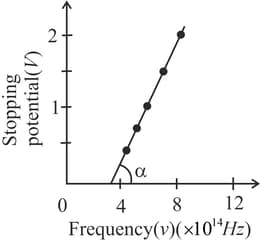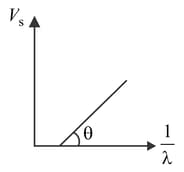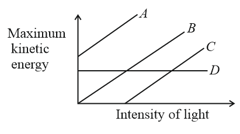The value of Plank's constant, if the slope of the graph of stopping potential vs frequency of incident light is is (given charge of an electron )
Important Questions on Dual Nature of Radiation and Matter

Electrons are emitted with kinetic energy from a metal plate by an irradiation of light of intensity and frequency Then, which of the following will be true?
In an experimental observation of the photoelectric effect, the stopping potential was plotted against the incident light frequency as shown in the figure below:

If the work function of the metal is given by , the angle is given by
(Here, and are Planck's constant and charge of electron respectively).
( = Planck's constant, = speed of light)
| 0.3 | 2.0 |
| 0.4 | 1.0 |
| 0.5 | 0.4 |
Given that Planck's constant (in units of ) found from such an experiment is :
In a photoelectric effect experiment, the graph of stopping potential versus reciprocal of wavelength obtained is shown in the figure. As the intensity of incident radiation is increased :

The graph between maximum kinetic energy and intensity of light in photoelectric effect is plotted. Out of the four graphs shown in the figure, the correct graph is

(Mass of electron )

